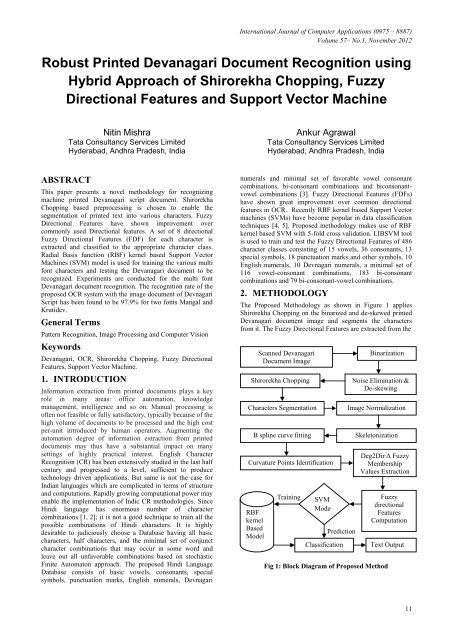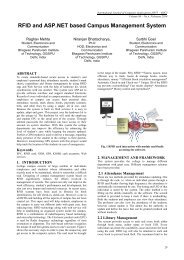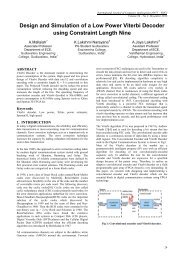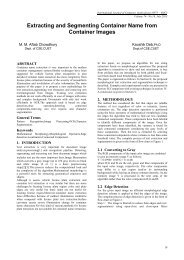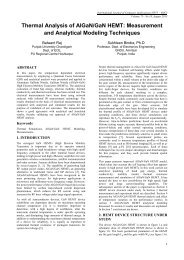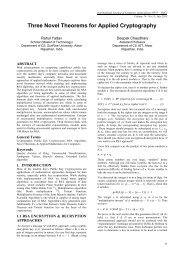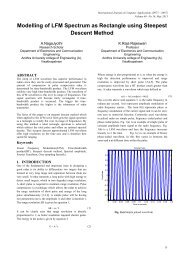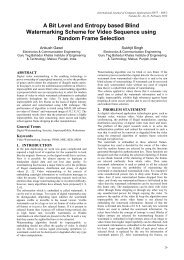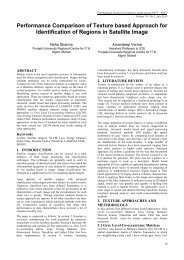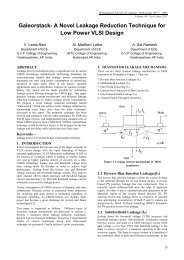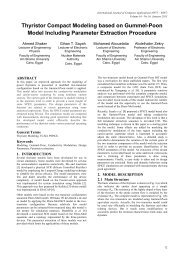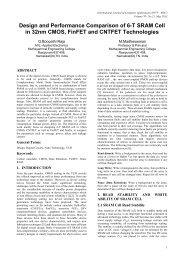Robust Printed Devanagari Document Recognition using Hybrid ...
Robust Printed Devanagari Document Recognition using Hybrid ...
Robust Printed Devanagari Document Recognition using Hybrid ...
Create successful ePaper yourself
Turn your PDF publications into a flip-book with our unique Google optimized e-Paper software.
International Journal of Computer Applications (0975 – 8887)<br />
Volume 57– No.1, November 2012<br />
<strong>Robust</strong> <strong>Printed</strong> <strong>Devanagari</strong> <strong>Document</strong> <strong>Recognition</strong> <strong>using</strong><br />
<strong>Hybrid</strong> Approach of Shirorekha Chopping, Fuzzy<br />
Directional Features and Support Vector Machine<br />
Nitin Mishra<br />
Tata Consultancy Services Limited<br />
Hyderabad, Andhra Pradesh, India<br />
Ankur Agrawal<br />
Tata Consultancy Services Limited<br />
Hyderabad, Andhra Pradesh, India<br />
ABSTRACT<br />
This paper presents a novel methodology for recognizing<br />
machine printed <strong>Devanagari</strong> script document. Shirorekha<br />
Chopping based preprocessing is chosen to enable the<br />
segmentation of printed text into various characters. Fuzzy<br />
Directional Features have shown improvement over<br />
commonly used Directional features. A set of 8 directional<br />
Fuzzy Directional Features (FDF) for each character is<br />
extracted and classified to the appropriate character class.<br />
Radial Basis function (RBF) kernel based Support Vector<br />
Machines (SVM) model is used for training the various multi<br />
font characters and testing the <strong>Devanagari</strong> document to be<br />
recognized. Experiments are conducted for the multi font<br />
<strong>Devanagari</strong> document recognition. The recognition rate of the<br />
proposed OCR system with the image document of Devnagari<br />
Script has been found to be 97.9% for two fonts Mangal and<br />
Krutidev.<br />
General Terms<br />
Pattern <strong>Recognition</strong>, Image Processing and Computer Vision<br />
Keywords<br />
<strong>Devanagari</strong>, OCR, Shirorekha Chopping, Fuzzy Directional<br />
Features, Support Vector Machine.<br />
1. INTRODUCTION<br />
Information extraction from printed documents plays a key<br />
role in many areas: office automation, knowledge<br />
management, intelligence and so on. Manual processing is<br />
often not feasible or fully satisfactory, typically because of the<br />
high volume of documents to be processed and the high cost<br />
per-unit introduced by human operators. Augmenting the<br />
automation degree of information extraction from printed<br />
documents may thus have a substantial impact on many<br />
settings of highly practical interest. English Character<br />
<strong>Recognition</strong> (CR) has been extensively studied in the last half<br />
century and progressed to a level, sufficient to produce<br />
technology driven applications. But same is not the case for<br />
Indian languages which are complicated in terms of structure<br />
and computations. Rapidly growing computational power may<br />
enable the implementation of Indic CR methodologies. Since<br />
Hindi language has enormous number of character<br />
combinations [1, 2]; it is not a good technique to train all the<br />
possible combinations of Hindi characters. It is highly<br />
desirable to judiciously choose a Database having all basic<br />
characters, half characters, and the minimal set of conjunct<br />
character combinations that may occur in some word and<br />
leave out all unfavorable combinations based on stochastic<br />
Finite Automaton approach. The proposed Hindi Language<br />
Database consists of basic vowels, consonants, special<br />
symbols, punctuation marks, English numerals, Devnagari<br />
numerals and minimal set of favorable vowel consonant<br />
combinations, bi-consonant combinations and biconsonantvowel<br />
combinations [3]. Fuzzy Directional Features (FDFs)<br />
have shown great improvement over common directional<br />
features in OCR. Recently RBF kernel based Support Vector<br />
machines (SVMs) have become popular in data classification<br />
techniques [4, 5]. Proposed methodology makes use of RBF<br />
kernel based SVM with 5-fold cross validation. LIBSVM tool<br />
is used to train and test the Fuzzy Directional Features of 486<br />
character classes consisting of 15 vowels, 36 consonants, 13<br />
special symbols, 18 punctuation marks and other symbols, 10<br />
English numerals, 10 Devnagari numerals, a minimal set of<br />
116 vowel-consonant combinations, 183 bi-consonant<br />
combinations and 79 bi-consonant-vowel combinations.<br />
2. METHODOLOGY<br />
The Proposed Methodology as shown in Figure 1 applies<br />
Shirorekha Chopping on the binarized and de-skewed printed<br />
<strong>Devanagari</strong> document image and segments the characters<br />
from it. The Fuzzy Directional Features are extracted from the<br />
Scanned <strong>Devanagari</strong><br />
<strong>Document</strong> Image<br />
Shirorekha Chopping<br />
Characters Segmentation<br />
B spline curve fitting<br />
Curvature Points Identification<br />
RBF<br />
kernel<br />
Based<br />
Model<br />
Training<br />
SVM<br />
Mode<br />
Prediction<br />
Classification<br />
Binarization<br />
Noise Elimination &<br />
De-skewing<br />
Image Normalization<br />
Skeletonization<br />
Deg2Dir ∆ Fuzzy<br />
Membership<br />
Values Extraction<br />
Fig 1: Block Diagram of Proposed Method<br />
Fuzzy<br />
directional<br />
Features<br />
Computation<br />
Text Output<br />
11
International Journal of Computer Applications (0975 – 8887)<br />
Volume 57– No.1, November 2012<br />
The segmentation issues related to Shirorekha based scripts<br />
are presented in [6, 7]. The Segmented Characters are trained<br />
and predicted <strong>using</strong> Radial Basis Function kernel based SVM<br />
model with 5–fold cross validation based automated<br />
parameters decision done by LIBSVM tool. The results show<br />
that the Proposed Approach for <strong>Devanagari</strong> OCR is quite<br />
efficient.<br />
अ<br />
a<br />
आ<br />
ा<br />
aa/A<br />
Table 1: General Vowels<br />
इ<br />
िा<br />
e/i<br />
ई<br />
ा<br />
ee/ii<br />
उ<br />
ा<br />
u<br />
ऊ<br />
ा<br />
oo/uu<br />
Anusvara<br />
ां<br />
Nukta<br />
ा<br />
Purna virama<br />
।<br />
Table 4: Special Symbols<br />
Visarga<br />
ाः<br />
Virama<br />
ा<br />
Deergha<br />
virama<br />
॥<br />
Chandra<br />
Bindu<br />
ा<br />
Udatta<br />
ा<br />
Avagraha<br />
ऽ<br />
Chandra<br />
ा<br />
Anudatta<br />
ा<br />
Grave<br />
Accent<br />
ा<br />
ए<br />
ऐ<br />
ओ<br />
औ<br />
अं<br />
अः<br />
Accute Accent<br />
ा<br />
ा<br />
ा<br />
ा<br />
ां<br />
ाः<br />
ा<br />
e<br />
ai<br />
o<br />
ou<br />
aM<br />
aH<br />
Table 5: Punctuation Marks and Other Symbols<br />
Table 2: Other Vowels<br />
“ ? ; % * / ( ) \<br />
ॠ<br />
ॡ<br />
ॐ<br />
= { } [ ] , - : !<br />
r^^<br />
l^^<br />
AUM<br />
Table 6: Numerals<br />
Table 3: Consonants<br />
० १ २ ३ ४ ५ ६ ७ ८ ९<br />
क<br />
ka<br />
ख<br />
kha<br />
ग<br />
ga<br />
घ<br />
gha<br />
ङ<br />
nga<br />
0 1 2 3 4 5 6 7 8 9<br />
च<br />
cha<br />
ट<br />
Ta<br />
छ<br />
chha<br />
ठ<br />
Tha<br />
ज<br />
ja<br />
ड<br />
Da<br />
झ<br />
jha<br />
ढ<br />
Dha<br />
ञ<br />
nja<br />
ण<br />
Na<br />
3. SHIROREKHA CHOPPING<br />
The global horizontal projection method computes sum of all<br />
black pixels on every row and constructs corresponding<br />
histogram. Based on the peak/valley points of the histogram,<br />
individual lines, words and characters are segmented.<br />
त<br />
ta<br />
प<br />
pa<br />
थ<br />
tha<br />
फ<br />
Pha/fa<br />
द<br />
da<br />
ब<br />
ba<br />
ध<br />
dha<br />
भ<br />
bha<br />
न<br />
na<br />
म<br />
ma<br />
3.1 Shirorekha Chopping Algorithm<br />
The steps of Shirorekha Chopping Algorithm are as follows:<br />
Input: Binarized Image of <strong>Devanagari</strong> <strong>Document</strong><br />
Output: Normalized Segmented Character Images<br />
य<br />
ya<br />
ष<br />
shh<br />
ज्ञ<br />
jnja<br />
र<br />
ra<br />
स<br />
sa<br />
ल<br />
la<br />
ह<br />
ha<br />
व<br />
va/wa<br />
क्ष<br />
ksh<br />
श<br />
Sha<br />
त्र<br />
tra<br />
3.1.1 Line Segmentation<br />
In line segmentation the aim is to draw one upper horizontal<br />
line and one lower horizontal line for each line of text image.<br />
The steps for line segmentation are as follow:<br />
1) Construct the Horizontal Histogram for the image.<br />
2) Using the Histogram, find the points from which the line<br />
starts and ends.<br />
3) For a line of text, upper line is drawn at a point where we<br />
start finding black pixels and lower line is drawn where<br />
we start finding absence of black pixels. And the process<br />
continues for next line and so on.<br />
12
International Journal of Computer Applications (0975 – 8887)<br />
Volume 57– No.1, November 2012<br />
3.1.2 Word Segmentation<br />
The steps for word segmentation are as follow:<br />
1) Construct the vertical histogram for each segmented line.<br />
2) Using the vertical Histogram, find the points from which<br />
the word starts and ends.<br />
3) Vertical lines are drawn at starting and ending points for<br />
each word.<br />
3.1.3 Character Segmentation<br />
The steps for character segmentation are as follow:<br />
1) Draw the horizontal histogram for each segmented line.<br />
2) From the horizontal histogram, find the row which<br />
consists of maximum value.<br />
3) The row which consists of maximum value of black pixel<br />
for each line is actually the row which consists of Header<br />
line also known as Shirorekha.<br />
4) Draw the vertical histogram for each segmented word.<br />
5) Using the histogram, find the points from which the<br />
character starts and ends.<br />
6) Draw line according these coordinate.<br />
7) Chop the Shirorekha at points at which distance between<br />
bottom of valley and x-axis of Vertical histogram<br />
becomes less than or equal to width of Header line.<br />
3.1.4 Bounding Box Generation<br />
1) Maintain the data structure to feed the line, word and<br />
character boundaries such that the character boundary<br />
could be sufficiently extracted from the image so that the<br />
bounding box is generated around each segmented<br />
character.<br />
3.1.5 Segmented Character Image Generation<br />
1) Each bounding box is cropped and segmented character<br />
images are normalized to same resolution.<br />
2) Return final character images.<br />
The concept of Shirorekha Chopping is illustrated in Fig 2.<br />
Input: Skeleton of Character Image<br />
Output: Series of Curvature points C= {c 1 , c 2 , ……… , c k }<br />
1) Let the Skeleton be represented by a series of 2D points<br />
as {(x 1, y 1 ), (x 2, y 2 ), ………………………….. , (x n, y n )}<br />
2) For i=1 to n-1 do<br />
a) if (x i - x i+1 ) >0<br />
i) x i´= +1<br />
b) else if (x i - x i+1 ) 0<br />
i) y i´= +1<br />
b) else if (y i - y i+1 )
International Journal of Computer Applications (0975 – 8887)<br />
Volume 57– No.1, November 2012<br />
5.1 Triangular Fuzzy Membership Values<br />
Extraction Algorithm<br />
The steps of the Algorithm are as follows:<br />
Input: Series of Curvature Points, C= {c 1 , c 2 , ……… , c k }<br />
Output: Matrix, m of size (k-1) x 8.<br />
1) Initialize Matrix, m of size (k-1) x 8 with initial value 0.0<br />
2) Let m i j be entry at i th row and j th column in the matrix, m.<br />
3) For i=1 to k-1 do<br />
a) θ i = tan -1 ((y i - y i+1 ) / (x i - x i+1 ))<br />
b) if θ i Є [ 7π/4, π/4) // CASE: 1<br />
i) m i 1 = 1.0-(abs(0 - θ i )/ (π/4))<br />
ii) if m i 1 ≠ 1.0 AND θ i 0<br />
m i 2 = 1.0-(abs(π/4 - θ i )/ (π/4))<br />
c) else if θ i Є [ 0, π/2 ) // CASE: 2<br />
i) m i 2 = 1.0-(abs(π/4 - θ i )/ (π/4))<br />
ii)<br />
if m i 2 ≠ 1.0 AND θ i π/4<br />
m i 3 = 1.0-(abs(π/2 - θ i )/ (π/4))<br />
d) else if θ i Є [ π/4, 3π/4 ) // CASE: 3<br />
i) m i 3 = 1.0-(abs(π/2 - θ i )/ (π/4))<br />
ii)<br />
if m i 3 ≠ 1.0 AND θ i π/2<br />
m i 4 = 1.0-(abs(3π/4 - θ i )/ (π/4))<br />
e) else if θ i Є [ π/2, π ) // CASE: 4<br />
i) m i 4 = 1.0-(abs(3π/4 - θ i )/ (π/4))<br />
ii)<br />
if m i 4 ≠ 1.0 AND θ i 3π/4<br />
m i 5 = 1.0-(abs(π - θ i )/ (π/4))<br />
f) else if θ i Є [ 3π/4, 5π/4 ) // CASE: 5<br />
i) m i 5 = 1.0-(abs(π - θ i )/ (π/4))<br />
ii) if m i 5 ≠ 1.0 AND θ i π<br />
m i 6 = 1.0-(abs(5π/4 - θ i )/ (π/4))<br />
g) else if θ i Є [ π, 3π/2 ) // CASE: 6<br />
i) m i 6 = 1.0-(abs(5π/4 - θ i )/ (π/4))<br />
ii)<br />
if m i 6 ≠ 1.0 AND θ i 5π/4<br />
m i 7 = 1.0-(abs(3π/2 - θ i )/ (π/4))<br />
h) else if θ i Є [ 5π/4, 7π/4 ) // CASE: 7<br />
i) m i 7 = 1.0-(abs(3π/2 - θ i )/ (π/4))<br />
ii)<br />
if m i 7 ≠ 1.0 AND θ i 3π/2<br />
m i 8 = 1.0-(abs(7π/4 - θ i )/ (π/4))<br />
i) else if θ i Є [ 3π/2, 2π ) // CASE: 8<br />
End<br />
i) m i 8 = 1.0-(abs(7π/4 - θ i )/ (π/4))<br />
ii)<br />
if m i 8 ≠ 1.0 AND θ i 7π/4<br />
m i 1 = 1.0-(abs(2π - θ i )/ (π/4))<br />
4) Return Matrix m having all Fuzzy Membership values.<br />
Fuzzy Aspect comes into the picture due to the membership<br />
function which associates the angle between two adjacent<br />
curvature points into two directions with different<br />
membership values. It is Also noted that if the angle Θ i has 2<br />
directions d j and d j+1 then m i<br />
j<br />
+ m i j+1 =1.0, where j Є {1, 2,..8}.<br />
5.2 Computation of Fuzzy Directional<br />
Features (FDF)<br />
The fuzzy membership values assigned to each direction are<br />
represented as m 1 1 , m 12· · · , m k-1<br />
8<br />
and these values are<br />
corresponding to f 1 , . . . , f 8 feature vector values and k<br />
curvature points. Here θ 1 , · · · θ k-1 are the angles between two<br />
consecutive curvature points (where k is the total number of<br />
curvature points) in a segmented character image. The FDF is<br />
calculated by averaging Matrix, m across the columns, so as<br />
to form a vector of dimension eight. The mean is calculated as<br />
follows; for each direction (1 to 8), collect all the membership<br />
values and divide by the number of occurrences of the<br />
membership values in that direction as shown in Fig 4. In all<br />
the experiments these mean values were used to construct the<br />
8 directional Fuzzy Directional Features to represent a<br />
Segmented Character .i.e., F = [f 1 , f 2 , . . . , f 8 ] where,<br />
f<br />
1<br />
1 1 1<br />
( m2 m3 m k 2)<br />
3<br />
.<br />
6. SUPPORT VECTOR MACHINE<br />
Recently, support vector machines (SVMs) have been a<br />
promising tool for the data classification [8]. Its basic idea is<br />
to map data into a high dimensional space and find a<br />
separating hyperplane with the maximal margin. Given<br />
training vectors x k Є R n , k = 1, . . . . . ,m in two classes, and a<br />
vector of labels y Є R m such that y k Є {1,−1}, SVM solves a<br />
quadratic optimization problem [9] :<br />
min<br />
wb , , 2<br />
m<br />
1 T<br />
w w C<br />
k<br />
k1<br />
14
1<br />
T<br />
Subject to <br />
y w x b ,<br />
k k k<br />
0 , k = 1, . . . . . ,m<br />
k<br />
Where training data are mapped to a higher dimensional space<br />
by the function and C is a penalty parameter on the training<br />
error. For any testing instance x , the decision function<br />
(predictor) is<br />
f ( x) sgn ( w T ( x) b)<br />
T<br />
Practically, we need only k( x, x') ( x) ( x')<br />
, the<br />
kernel function to train the SVM. The RBF kernel is used in<br />
proposed approach:<br />
k x x x x<br />
2<br />
( , ') exp( <br />
|| '|| )<br />
With the RBF kernel there are two parameters to be<br />
determined in the SVM model: C and . To get good<br />
θ↓) d→)<br />
International Journal of Computer Applications (0975 – 8887)<br />
Volume 57– No.1, November 2012<br />
generalization ability validation process is conducted to<br />
decide the parameters. The procedure is as follows:<br />
1) Consider a grid space of ( C, ) with<br />
{ 5, 3,...,15} and<br />
2<br />
log2<br />
C Є<br />
log Є { 15, 13,...,3}<br />
2) For each hyperparameter pair ( C, ) in the search<br />
space, conduct 5-fold cross validation on the training set.<br />
3) Choose the parameter ( C, ) that leads to lowest CV<br />
balanced error rate.<br />
4) Finally use the best parameter to create a model as the<br />
predictor.<br />
LIBSVM tool recommends linearly scaling each feature to the<br />
range [-1, +1] or [0, 1] before SVM training or matching<br />
phase. As All the Fuzzy Directional Features are in the range<br />
[0, 1], there is no need to rescale the features and the<br />
experiments are easily conducted <strong>using</strong> LIBSVM tool [10].<br />
1 2 3 4 5 6 7 8<br />
Θ 1<br />
Θ 2<br />
Θ 3<br />
.<br />
.<br />
.<br />
.<br />
Θ i<br />
.<br />
.<br />
Θ k-2<br />
Θ k-1<br />
0<br />
m 2<br />
1<br />
m 3<br />
1<br />
0<br />
m k-2<br />
1<br />
0<br />
0<br />
m 2<br />
2<br />
0<br />
0<br />
m k-2<br />
2<br />
0<br />
m 1<br />
3<br />
0<br />
0<br />
0<br />
0<br />
0<br />
m 1<br />
4<br />
0<br />
0<br />
0<br />
0<br />
0<br />
0<br />
0<br />
0<br />
0<br />
0<br />
m k-1<br />
5<br />
0<br />
0<br />
0<br />
0<br />
0<br />
m k-1<br />
6<br />
0<br />
0<br />
0<br />
m i<br />
7<br />
0<br />
0<br />
0<br />
0<br />
m 3<br />
8<br />
m i<br />
8<br />
0<br />
0<br />
F<br />
f 1 =<br />
(m 2 1 +<br />
m 3 1 +<br />
m k-2 1 )/3<br />
f 2 =<br />
(m 2 2 +<br />
m k-2 2 )/2<br />
f 3 =<br />
m 1<br />
3<br />
f 4 =<br />
m 1<br />
4<br />
f 5 =<br />
m k-1<br />
5<br />
f 6 =<br />
m k-1<br />
6<br />
f 7 =<br />
m i<br />
7<br />
f 8 =<br />
(m 3 8 +<br />
m i 8 )/2<br />
Fig 4: Computation of Fuzzy Directional Features from Matrix m<br />
7. EXPERIMENTAL RESULTS<br />
This section presents the experimental results. After applying<br />
the Shirorekha Chopping the characters are easily segmented.<br />
The skeletons of the segmented characters are generated and<br />
B spline curves are fitted in order to smooth the skeleton and<br />
find the curvature points. Once the curvature points in the<br />
segmented character image are identified the relative angle<br />
between adjacent curvature points are computed and fed into<br />
the process of Fuzzy Directional Features extraction.<br />
Fig 5: Curvature Points Identification<br />
All FDFs are trained/predicted <strong>using</strong> RBF kernel based SVM<br />
with 5-fold cross validation parameters adjustment. In 5-fold<br />
cross validation, training set is divided into 5 subsets of equal<br />
size. Sequentially one subset is tested <strong>using</strong> the classifier<br />
trained on the remaining 4 subsets. Thus, each instance of the<br />
15
International Journal of Computer Applications (0975 – 8887)<br />
Volume 57– No.1, November 2012<br />
whole training set is predicted once so the cross-validation<br />
accuracy is the percentage of data which are correctly<br />
classified.<br />
Table 7: Parameters Selection<br />
Cost<br />
Parameter,<br />
C<br />
Gamma<br />
Parameter,<br />
g<br />
# of Cross<br />
Validation,<br />
Test 1 5 2.0 0<br />
Test 2 2 1.0 10<br />
Test 3 0.03125 0.0078 5<br />
Table 7 shows the Initial Test for the Best Parameters<br />
selections for the training of character classes by LIBSVM.<br />
After a number of tests it was observed that Test 3 was most<br />
favourable for the training phase. Thus Parameter C, g and v<br />
were globally set to 0.03125, 0.0078 and 5 respectively.<br />
Table 8: Characters Classification Test<br />
Trained<br />
classes<br />
Test samples<br />
v<br />
Correct<br />
classifications<br />
Test A 486 486 459<br />
Test B 486 100 97<br />
Test C 486 1000 989<br />
Table 8 shows the performance of the tests conducted for the<br />
Characters Classification. Finally According to the correct<br />
classifications and misclassifications, the average recognition<br />
accuracy was found to be 97.9%.<br />
Table 9: <strong>Recognition</strong> Accuracy<br />
<strong>Recognition</strong><br />
Accuracy<br />
Mean Square Error<br />
Test A 94.4% 0.86<br />
Test B 97.0% 0.425<br />
Test C 98.9% 0.157<br />
8. CONCLUSIONS<br />
There is a significant improvement in the recognition<br />
accuracy in the <strong>Devanagari</strong> OCR after integrating Shirorekha<br />
Chopping with Fuzzy Directional Features and Support<br />
Vector Machine. Table 9 shows the higher recognition<br />
accuracy for SVM based on RBF kernel.<br />
9. REFERENCES<br />
[1] Bansal, V. and Sinha, R.M.K. “A Complete OCR for<br />
<strong>Printed</strong> Hindi Text in Devnagari Script”, Sixth<br />
International Conference on <strong>Document</strong> Analysis and<br />
<strong>Recognition</strong>, IEEE Publication, Seatle USA, 2001,<br />
Page(s):800-804.<br />
[2] Jindal, M.K., Sharma, R.K., lehal, G.S. “A Study of<br />
Different Kinds of Degradation in <strong>Printed</strong> Gurmukhi<br />
Script”, Proceedings of the International Conference on<br />
Computing: Theory and Applications (ICCTA'07),2007.<br />
[3] Yadav, D., Sharma, A.K. and Gupta, J.P. Optical<br />
character recognition for printed Hindi text in<br />
<strong>Devanagari</strong> <strong>using</strong> soft-computing technique, IASTED<br />
International Multi-Conference: Artificial Intelligence<br />
and Applications, Innsbruck, Austria, 2007, pp. 102-107<br />
[4] Chaudhuri, B. B. and Pal, U. "An OCR System to Read<br />
Two Indian Language Scripts: Bangla and Devnagari<br />
(Hindi)", Proc. of 4th ICDAR vol.2, Ulm, Germany,<br />
1997, Page(s): 1011 -1015<br />
[5] Pal, U., Chaudhuri, B. B. ''Indian Script Character<br />
recognition: A survey'', Pattern <strong>Recognition</strong>, vol. 37, pp.<br />
1887-1899, 2004..<br />
[6] Agrawal, P., Hanmandlu, M. and Lall, B., “Coarse<br />
Classification of Handwritten Hindi Characters”,<br />
International Journal of Advanced Science and<br />
Technology,Vol. 10, September, 2009.<br />
[7] Saba, T., Sulong, G. and Rehman, A. “A Survey on<br />
Methods and Strategies on Touched Characters<br />
Segmentation”, International Journal of Research and<br />
Reviews in Computer Science (IJRRCS) Vol. 1, No. 2,<br />
June 2010.<br />
[8] Claus Bahlmann, Bernard Haasdonk, and Hans<br />
Burkhardt. On-line handwriting recognition with support<br />
vector machines.a kernel approach. In Proc. of the 8th<br />
IWFHR, pages 49.54, 2002.<br />
[9] G. C. Cawley. MATLAB support vector machine<br />
toolbox (v0.55¯) University, of East Anglia, School of<br />
Information Systems, Norwich, Norfolk, U.K., 2000.<br />
available<br />
at:<br />
[http://theoval.sys.uea.ac.uk/.gcc/svm/toolbox].<br />
[10] Chih-Chung Chang and Chih-Jen Lin, LIBSVM : a<br />
library for support vector machines. ACM Transactions<br />
on Intelligent Systems and Technology, 2:27:1—27:27,<br />
2011. The Software available at<br />
http://www.csie.ntu.edu.tw/~cjlin/libsvm<br />
16


